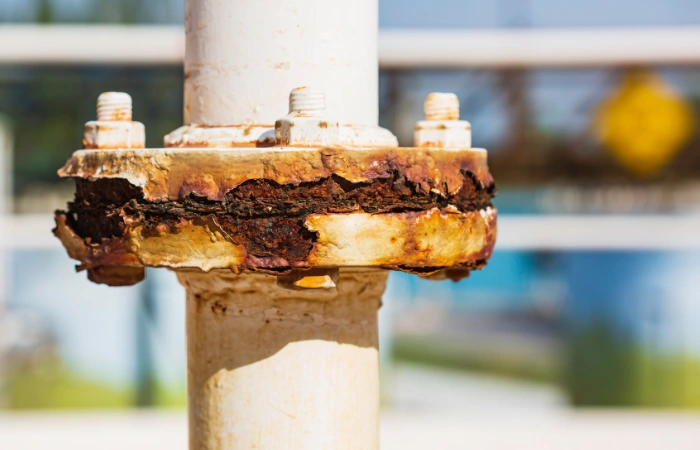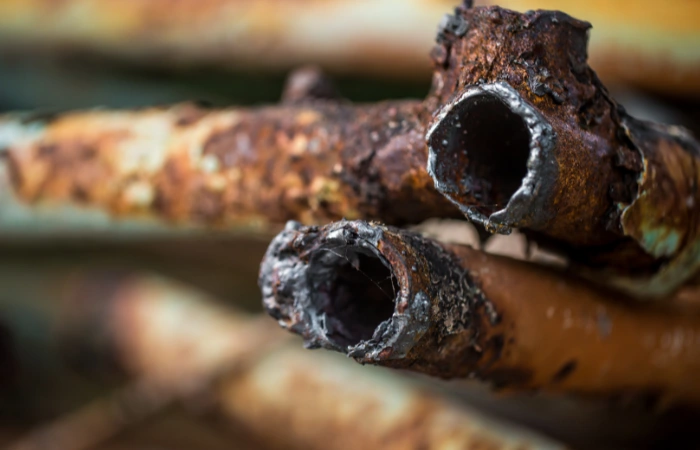
Pipe corrosion is a prevalent issue that affects plumbing systems across various settings, from residential homes to industrial facilities. Understanding the causes of corrosion of pipes and how to effectively address them is essential for maintaining the integrity of your plumbing and avoiding costly damage. This blog will explore the causes of pipe corrosion, discuss the methods to fix it and provide insights into how to prevent it in the future.
What Is Pipe Corrosion?
Pipe corrosion is the slow breakdown of metal pipes due to chemical reactions with their surroundings. This deterioration weakens the pipe material, which leads to leaks, bursts, and contamination of water supplies. The most common types of pipe corrosion include uniform corrosion, pitting corrosion, and galvanic corrosion, each with distinct characteristics and causes.
Uniform corrosion spreads evenly over the metal surface, gradually thinning the pipe walls. Pitting corrosion is when small but deep holes form in one spot of the pipe, which can make it weak quickly. Galvanic corrosion happens when two different metals touch in the presence of an electrolyte, causing accelerated corrosion of one metal compared to the other.
What Causes Pipe Corrosion?
Knowing the causes of pipe corrosion is crucial for prevention and remediation. Several factors contribute to this issue, each interacting in complex ways that can greatly impact the longevity and performance of piping systems.
1. Water Quality
The quality of the water flowing through pipes is a substantial factor in corrosion of pipes. High levels of acidity (low pH), alkalinity (high pH), or dissolved oxygen can accelerate corrosion. Hard water, which contains high levels of minerals like calcium and magnesium, can lead to scaling inside pipes. This scale buildup can cause localized corrosion underneath deposits and can impede water flow, leading to increased pressure and erosion-corrosion.
2. Chemical Reactions
In plumbing systems, the interaction between different metals can trigger galvanic corrosion. This occurs when two different metals meet while water, an electrolyte, is present. As a result, an electrochemical reaction takes place, causing one metal to corrode rapidly while the other remains protected. Common combinations that can result in galvanic corrosion include copper and steel or aluminum and stainless steel.
3. Microbial Activity
Certain bacteria, like sulfate-reducing bacteria, can influence the corrosion process. These bacteria produce hydrogen sulfide, a corrosive gas, as a metabolic by-product. The presence of these bacteria and their by-products can create highly localized corrosion, known as microbiologically influenced corrosion (MIC).
4. Oxygen Exposure
Oxygen dissolved in water or present in the environment can lead to oxidation reactions, which results in rust formation on iron and steel pipes. This oxidation weakens the pipe structure over time. In systems where water is intermittently stagnant and flowing, repeated exposure to oxygen can exacerbate this process.
5. Temperature
Elevated temperatures generally increase the rate of chemical reactions, including those that cause corrosion. Hot water systems are particularly vulnerable to corrosion because the increased temperature accelerates the degradation processes.
6. Flow Velocity
The speed and turbulence of water flow within pipes can contribute to corrosion. High flow rates can cause erosion-corrosion, where the physical impact of water and any abrasive particles it carries wear away the protective oxide layer on the metal surface, exposing it to further chemical attack.
7. External Factors
The environment surrounding buried pipes can significantly influence corrosion rates. Soil composition, moisture levels, and the presence of corrosive substances in the soil can all affect the exterior of pipes. For example, soils with high chloride content can accelerate the corrosion of buried metal pipes.
How to Address Pipe Corrosion

Addressing pipe corrosion involves both preventive measures and remedial actions. Implementing these strategies can help extend the lifespan of your piping system and prevent future issues.
Regular Inspections
Regularly inspecting your plumbing system can aid in identifying early signs of pipe corrosion, such as discoloration, leaks, or rust stains. Early detection allows for timely intervention before significant damage occurs. Qualified professionals should conduct these inspections to precisely evaluate your pipes’ condition and suggest suitable actions.
Water Treatment
Treating water to balance pH levels, remove dissolved oxygen, and reduce hardness can mitigate the chemical reactions that cause corrosion. Installing water softeners, pH neutralizers, and de-aeration systems are common methods used in water treatment. These treatments can help prevent scale buildup and reduce the corrosive potential of water.
Pipe Coatings and Linings
Applying protective coatings or linings to the interior or exterior of pipes can provide a barrier against corrosive substances. Common materials used include epoxy, polyurethane, and cement mortar linings, which protect the metal surface from direct contact with corrosive elements. These coatings can be applied during the manufacturing process or retrofitted to existing pipes.
Material Selection
Using corrosion-resistant materials such as PVC, CPVC, or stainless steel can prevent pipe corrosion from occurring. When installing new plumbing systems or replacing old pipes, selecting materials known for their resistance to specific types of corrosion is crucial. For instance, stainless steel exhibits remarkable resistance to many forms of corrosion, making it an excellent choice for critical applications.
Repair and Replacement
For severely corroded pipes, repair or replacement is necessary. Spot repairs can address localized damage, while extensive corrosion might require complete pipe replacement. In some cases, trenchless technology can be used to replace or reline pipes without extensive excavation. This method minimizes disruption and reduces costs associated with traditional pipe replacement techniques.
Flow Management
Regulating the flow velocity and turbulence within pipes can help reduce erosion-corrosion. Installing flow control devices, such as flow restrictors or pressure regulators, can manage the speed and pressure of water within the system. Additionally, ensuring that the piping design minimizes sharp bends and abrupt changes in diameter can help maintain smooth flow and prevent areas of high turbulence.
FAQs
How can I tell if my pipes are corroded?
Signs of pipe corrosion include discoloration of water, metallic taste, low water pressure, leaks, rust stains on fixtures, and unusual noises from the plumbing system. Regular inspections can help detect corrosion early.
Can corroded pipes lead to health hazards?
Yes, corroded pipes can compromise water quality by leaching metals and other contaminants into the water supply. Consuming contaminated water can pose health risks, including gastrointestinal issues and exposure to toxic substances.
Is pipe corrosion a serious issue?
Yes. It can lead to numerous problems, including leaks, reduced water pressure, water contamination, and even pipe bursts. These issues can cause significant damage to property, result in costly repairs, and pose health risks due to contaminated water. Therefore, addressing it promptly and effectively is crucial to maintaining the integrity and functionality of any plumbing system.
Conclusion
Pipe corrosion is a significant concern that requires attention to maintain the longevity and safety of plumbing systems. By grasping the causes and implementing effective prevention and remediation strategies, you can protect your pipes from corrosion and avoid costly repairs.
For professional assistance with pipe corrosion issues, contact True Plumbing Solutions. Our seasoned team can provide expert advice and services to uphold the optimal condition of your plumbing system. Get in touch with us today!
